
NECO 2024 AGRIC QUESTIONS;-ExamgrandComNg
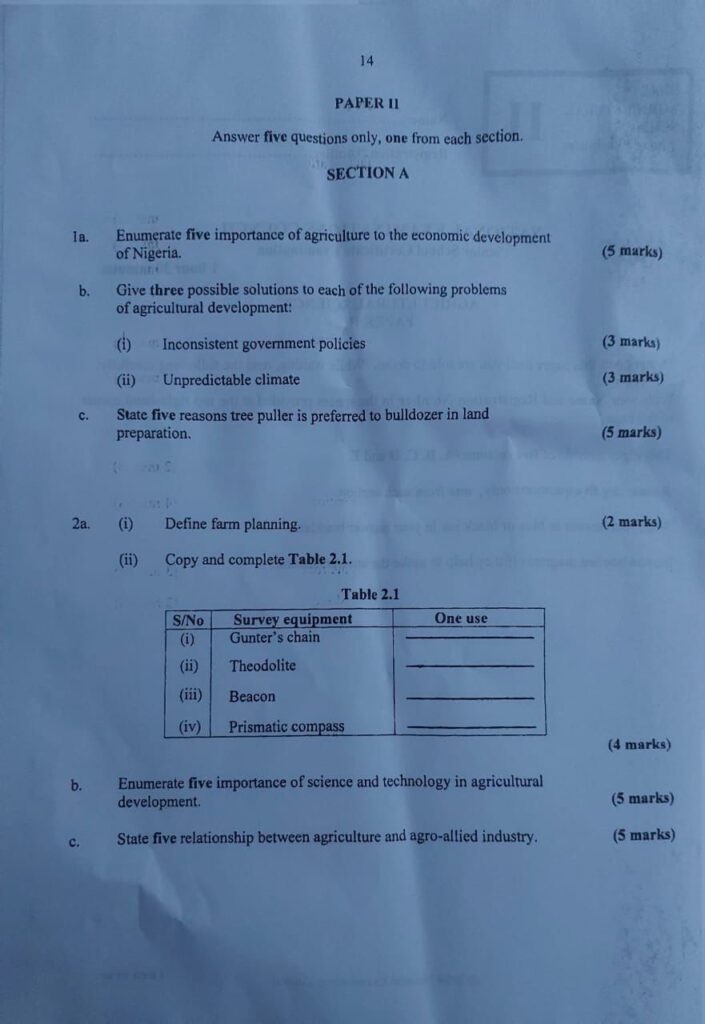
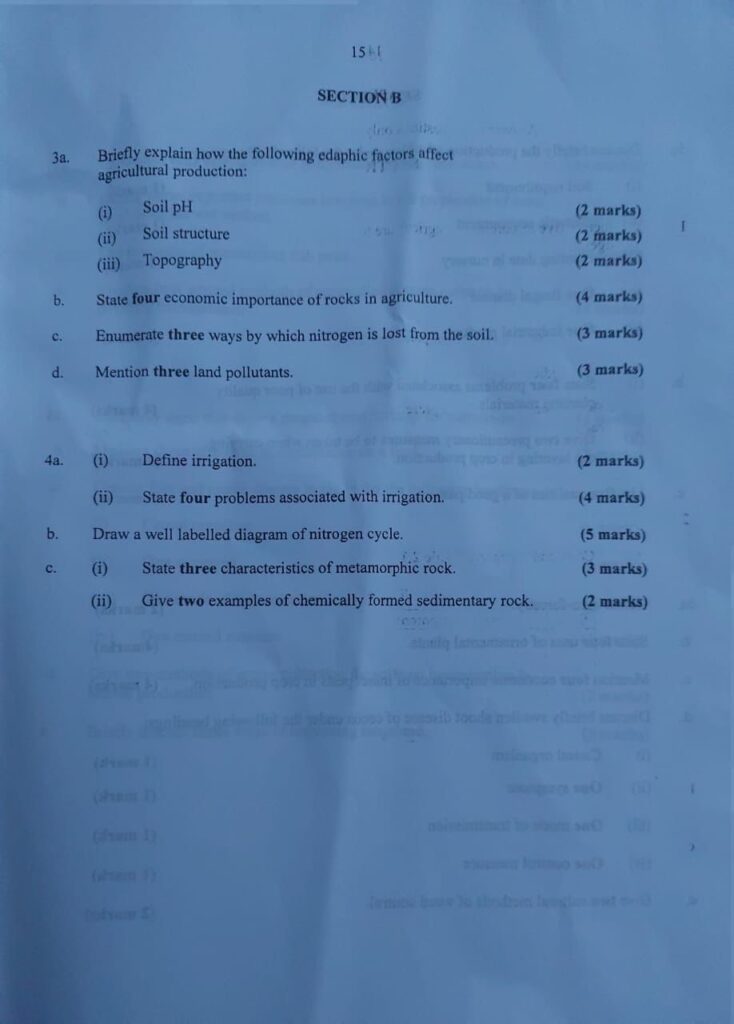
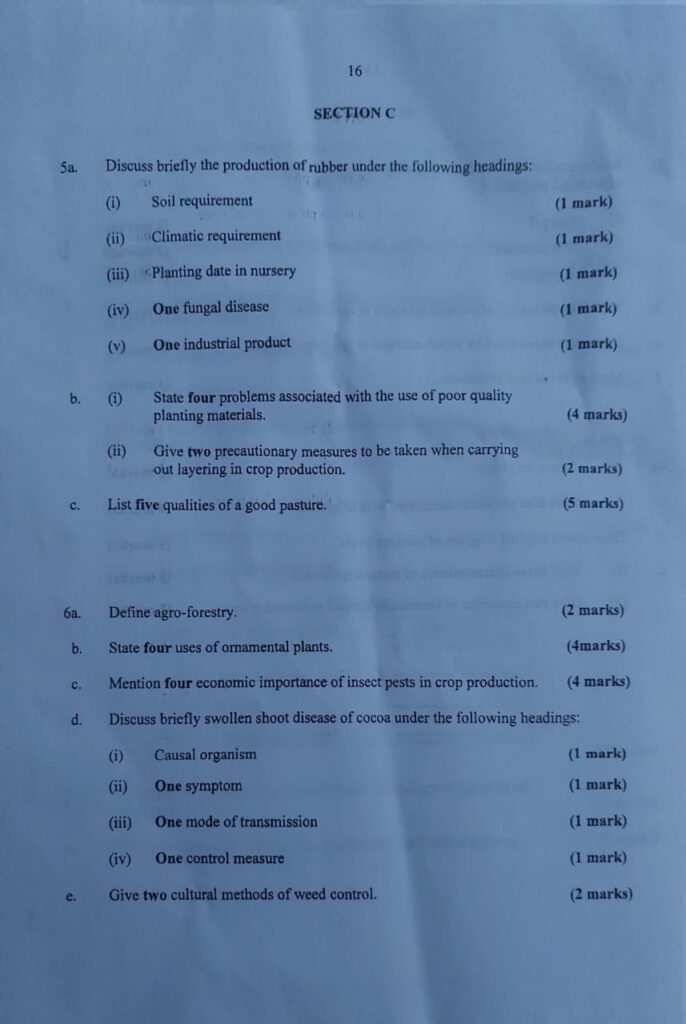
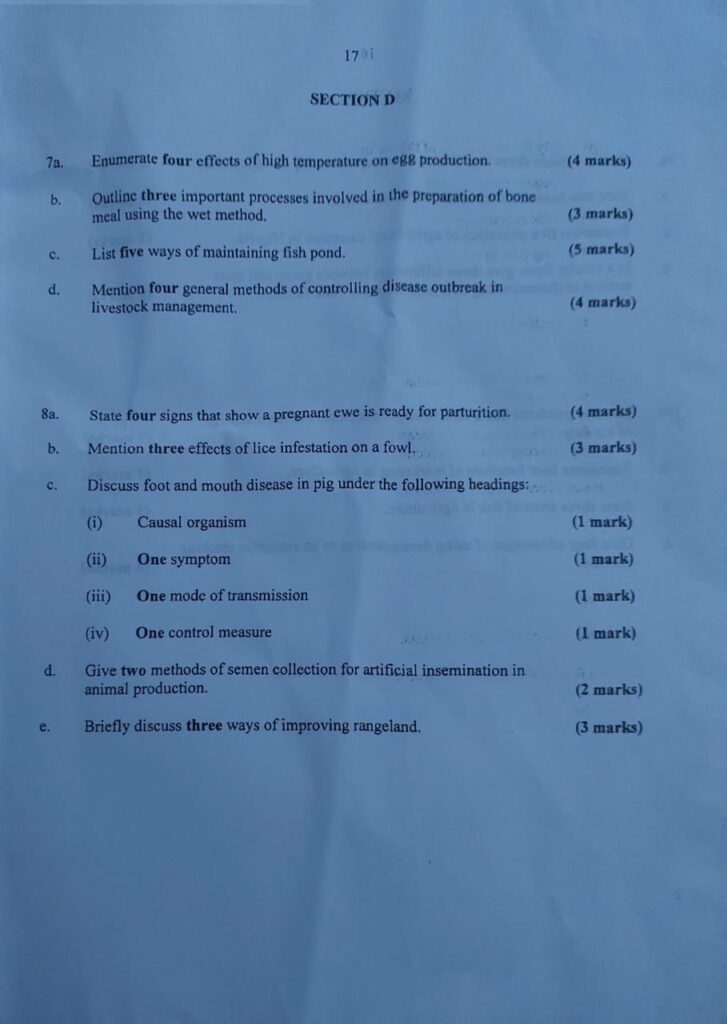
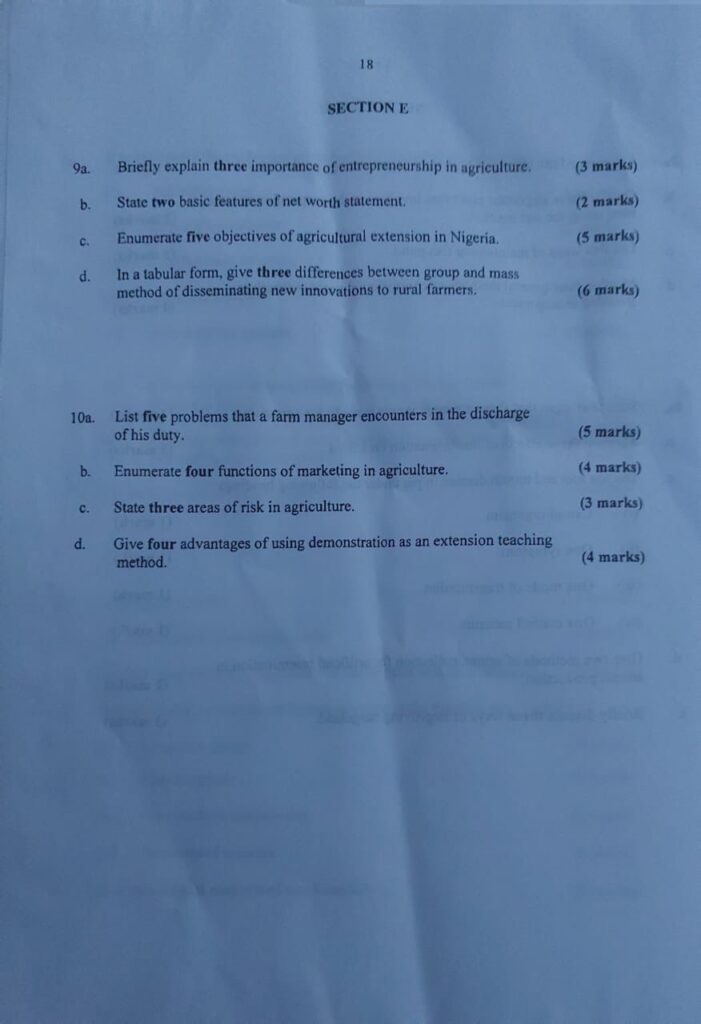
2024 NECO AGRICULTURAL SCIENCE OBJ;-ExamgrandComNg
01-10: CADBDBEDBA
11-20: EADDADACAC
21-30: CCAEADADDE
31-40: BBACCCDBCD
41-50: AACEDAADAC
51-60: EEDACEBDAC
COMPLETED
✅✅✅✅✅✅✅✅✅✅✅✅
NECO 2024 AGRIC ANSWERS;-ExamgrandComNg
(1a)
(PICK ANY FIVE)
(i) Agriculture is the primary source of employment in Nigeria, employing about 70% of the labor force.
(ii) It provides food for the increasing population, ensuring food security.
(iii) Agriculture supplies raw materials to industries, such as cotton for the textile industry and cocoa for the confectionery industry.
(iv) Export of agricultural products like cocoa, palm oil, and rubber provides foreign exchange earnings.
(v) Agriculture fosters rural development through the provision of infrastructure like roads, schools, and healthcare facilities.
(vi) The agricultural sector contributes significantly to the national GDP and government revenue through taxes and exports.
(vii) Agriculture helps diversify the economy, reducing dependence on the oil sector.
(1bi) Inconsistent government policies:
(PICK ANY THREE)
(i) Establishing a consistent agricultural policy framework that is resistant to frequent changes by successive governments.
(ii) Involving all stakeholders in policy formulation to ensure that policies are realistic and implementable.
(iii) Setting up mechanisms for regular monitoring and evaluation of agricultural policies to ensure they are effectively implemented and adjusted as needed.
(iv) Providing incentives for policy adherence and discouraging abrupt policy changes.
(1bii) Unpredictable climate:
(PICK ANY THREE)
(i) Developing and promoting the use of climate-resilient crop varieties that can withstand extreme weather conditions.
(ii) Investing in irrigation infrastructure to reduce dependence on rain-fed agriculture.
(iii) Enhancing weather forecasting and early warning systems to help farmers make informed decisions.
(iv) Promoting sustainable agricultural practices that can mitigate the effects of climate change.
(1c)
(PICK ANY FIVE)
(i) Tree pullers can selectively remove trees without disturbing other vegetation.
(ii) They can pull out entire trees, including roots, reducing the chances of regrowth.
(iii) Tree pullers cause less soil disturbance compared to bulldozers, preserving soil structure and fertility.
(iv) They are generally more cost-effective for small to medium-scale land clearing operations.
(v) Tree pullers have a lower environmental impact, causing less destruction to the ecosystem compared to bulldozers.
(vi) They are often more efficient in terms of time and labor for clearing smaller areas.
(vii) Less disturbance to the soil helps in preserving beneficial soil microorganisms
=======================================
(2a) Farm planning is the process of organizing and managing resources and operations on a farm to maximize productivity and profitability. It involves making decisions about crop selection, livestock management, land use, financial planning, and implementing strategies to achieve short-term and long-term agricultural goals.
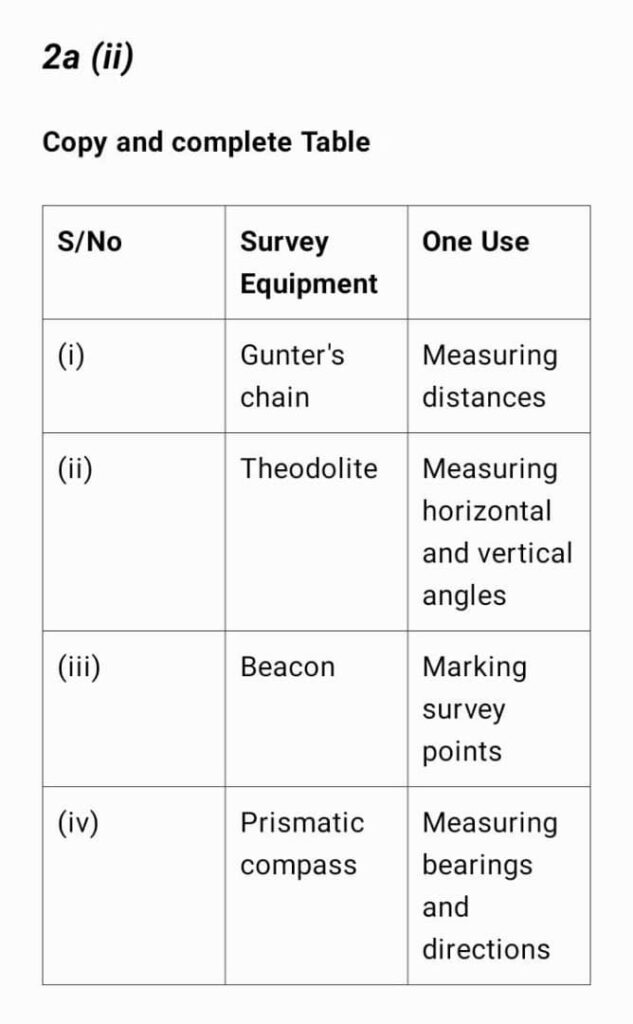
(2b)
i.Increased Productivity: Science and technology enhance crop yields and livestock production through advanced breeding techniques, pest control, and soil management.
ii.Efficient Resource Use: Innovations in irrigation, fertilization, and crop management optimize the use of water, nutrients, and land.
iii.Pest and Disease Management: Biotechnology and chemical research provide effective solutions for controlling pests and diseases, reducing losses.
iv.Climate Adaptation: Technological advancements help develop crops that are resistant to extreme weather conditions and adaptable to changing climates.
v.Data-Driven Decisions: Precision agriculture uses data analytics, GPS, and sensors to make informed decisions, improving efficiency and sustainability.
(2c)
i. Supply Chain Integration: Agriculture provides raw materials (crops, livestock) to agro-allied industries for processing into food, beverages, textiles, and biofuels.
ii.Value Addition: Agro-allied industries add value to agricultural produce through processing, packaging, and distribution, increasing marketability and profitability.
iii. Employment Generation:- Both sectors create employment opportunities, from farming and harvesting to processing, marketing, and sales.
iv. Economic Growth:- The interdependence of agriculture and agro-allied industries drives economic development, contributing to GDP and export earnings.
v.Technological Transfer:- Innovations in agro-allied industries often trickle down to farming practices, enhancing productivity and sustainability on farms.
=======================================
(3a)
(i) Soil pH:
Soil pH affects the availability of nutrients to plants and the activity of soil microorganisms. For example, a very acidic soil (low pH) can lead to nutrient deficiencies or toxicities, hindering plant growth.
(ii) Soil Structure:
Soil structure refers to the arrangement of soil particles into aggregates. Good soil structure improves aeration, water infiltration, and root penetration, enhancing plant growth. Poor soil structure can lead to compaction, reducing root growth and water movement.
(iii) Topography:
Topography influences drainage, erosion, and the microclimate of an area. Steep slopes can lead to erosion and loss of topsoil, while flat areas may have poor drainage, affecting crop yield.
(3b)
(PICK ANY FOUR)
(i) Rocks weather over time to form soil, which is the medium for plant growth.
(ii) Rocks release essential minerals and nutrients into the soil as they break down.
(iii) Rocks are used in constructing agricultural infrastructure like farm buildings and roads.
(iv) Certain types of rocks help in retaining moisture in the soil, beneficial for crop growth.
(v) Rocks can be used to create terraces on hilly terrain, reducing soil erosion and improving arable land.
(3c)
(PICK ANY THREE)
(i) Nitrogen, particularly in the nitrate form, can be leached away from the soil profile by percolating water.
(ii) Microbial processes in waterlogged soils convert nitrates to nitrogen gas, which is lost to the atmosphere.
(iii) Ammonia from fertilizers can volatilize and be lost to the atmosphere, especially in alkaline soils.
(iv) Nitrogen is taken up by crops and removed from the soil when the crops are harvested.
(3d)
(PICK ANY THREE)
(i) Pesticides
(ii) Herbicides
(ii) Heavy metals
(iii) Plastics
(iv) Industrial chemicals
(v) Petroleum products
(vi) Agricultural runoff
(vii) Sewage and wastewater
=======================================
(4ai)
PICK ANY ONE
Irrigation is the practice of applying controlled amounts of water to land to help grow crops, landscape plants, and lawns.
OR
Irrigation is the artificial application of water to the soil to assist in the growth of crops.
(4aii)
(PICK ANY FOUR)
(i) Excessive irrigation can lead to waterlogged soils, reducing oxygen availability to roots.
(ii) Over-irrigation, especially in arid areas, can lead to the accumulation of salts in the soil, affecting crop growth.
(iii) The infrastructure and energy required for irrigation can be expensive, limiting its accessibility.
(iv) Intensive irrigation can deplete local water resources, affecting other uses and ecosystems.
(v) Improper irrigation practices can lead to soil erosion, reducing soil fertility.
(vi) Irrigation can create standing water, which can become breeding grounds for mosquitoes and other disease vectors.
(4b)
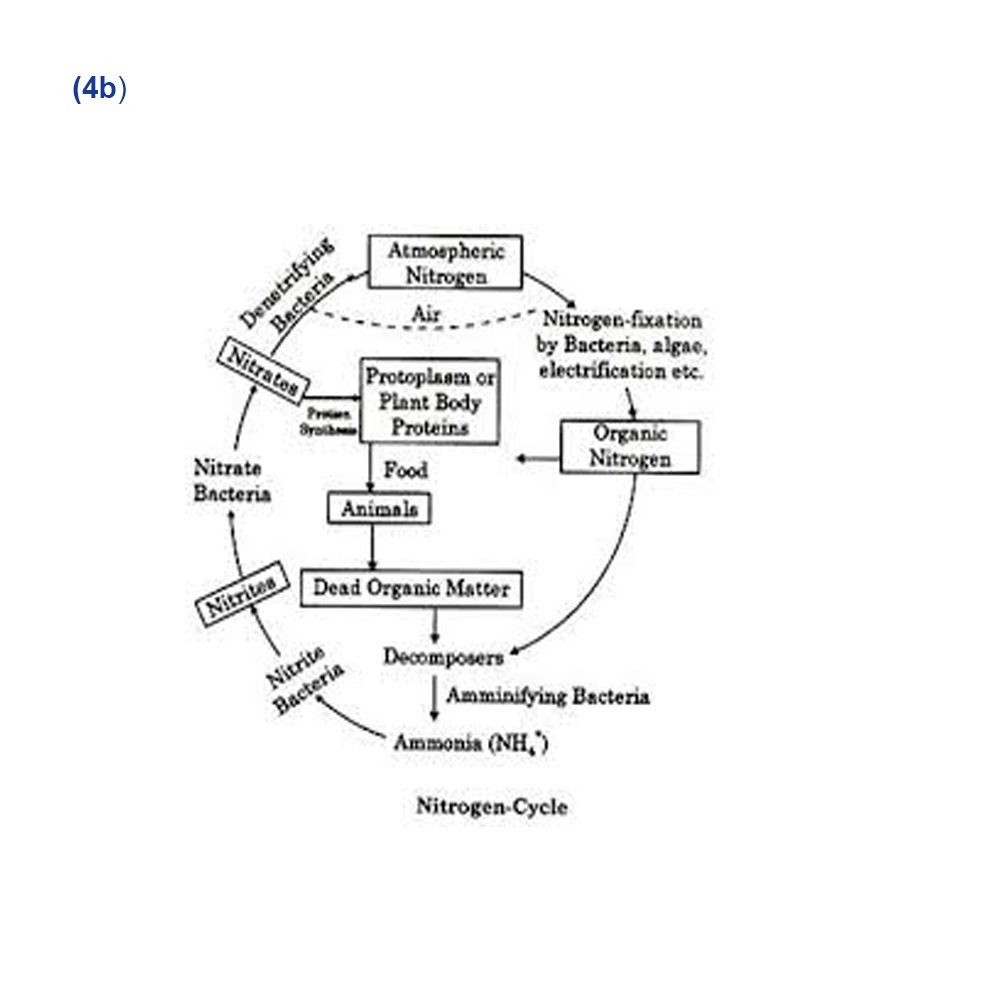
(4c)
(PICK ANY THREE)
(i) Metamorphic rocks are generally harder and more resistant to weathering than their original forms due to recrystallization.
(ii) Many metamorphic rocks have a banded or foliated texture, where minerals are aligned in planes.
(iii) Metamorphic rocks often undergo recrystallization, forming new mineral structures without melting.
(iv) Metamorphic rocks often have a higher density than the original rocks due to the pressure they were subjected to during formation.
(v) Metamorphic rocks contain minerals that are stable under high pressure and temperature conditions
(4c)
(PICK ANY TWO)
(i) Limestone
(ii) Gypsum
(iii) Halite (rock salt)
(iv) Chert
(v) Dolomite
=======================================
(5a)
(i) Soil requirement: Rubber trees thrive best in well-drained, deep, loamy soils rich in organic matter with good water retention capacity and a pH range of 4.5 to 6.5.
(ii) Climatic requirement: Rubber trees require a hot, humid climate with consistent rainfall ranging from 2000 to 3000 mm annually. They thrive in temperatures between 25°C and 35°C and need a frost-free environment.
(iii) Planting date in nursery: Rubber seeds are typically sown in the nursery at the beginning of the rainy season, which ensures adequate moisture for germination. This period varies by region but generally falls between May and July.
(iv) One fungal disease: Powdery mildew is a common fungal disease affecting rubber trees.
(v) One industrial product: Natural rubber is a significant industrial product derived from rubber trees.
(5bi)
(PICK ANY FOUR)
(i) Reduced crop yield
(ii) Increased susceptibility to diseases
(iii) Poor growth and development
(iv) Low-quality produce
(v) Increased pest infestation
(vi) Higher cost of production due to additional inputs required
(5bii)
(PICK ANY TWO)
(i) Use healthy and disease-free parent plants
(ii) Ensure the layering medium is moist but well-drained
(iii) Avoid damaging the stem during the process
(iv) Protect the layered part from pests and harsh environmental conditions
(5c)
(PICK ANY FIVE)
(i) High nutritional value
(ii) Good palatability for livestock
(iii) Resistance to pests and diseases
(iv) Adaptability to local climate and soil conditions
(v) High yield potential
(vi) Persistent growth throughout the grazing season
(vii) Ability to recover quickly after grazing
=======================================
(6a)
Agroforestry is a land use management system that combines trees and shrubs with crops and/or livestock in a way that allows them to interact beneficially.
(6b)
(PICK ANY FOUR)
(i) Beautification of gardens, parks, and landscapes.
(ii) Indoor decoration in homes and offices.
(iii) Floral arrangements for events and ceremonies.
(iv) Screening or hedging to provide privacy.
(v) Medicinal and aromatic purposes.
(vi) Wildlife habitat and food sources.
(6c)
(PICK ANY FOUR)
(i) Reduction in crop yield and quality.
(ii) Increased production costs due to pest control measures.
(iii) Loss of market value for damaged produce.
(iv) Disruption of export trade due to quarantine restrictions.
(v) Spread of plant diseases through insect vectors.
(vi) Development of resistance in pest populations to control measures.
(6di)
Causal organism: The causal agent of swollen shoot disease in cocoa is the Cocoa swollen shoot virus (CSSV), which belongs to the genus “Cocaduvirus.”
(6dii)
One symptom: One prominent symptom of swollen shoot disease is the characteristic swelling or enlargement of the terminal buds of cocoa branches and shoots, leading to a distortion of plant growth.
(6diii)
One mode of transmission: The virus is primarily transmitted through the planting of infected vegetative propagules such as cuttings or buds from infected trees.
(6div)
One control measure: One control measure for swollen shoot disease is the strict sanitation of infected trees by uprooting and destroying them to prevent further spread of the virus. Additionally, planting of disease-resistant cocoa varieties can help manage the disease.
(6e)
(PICK ANY TWO)
(i) Mulching
(ii) Crop rotation
(iii) Hand weeding
(iv) Planting competitive crops
=======================================
(7a)
(PICK ANY FOUR)
(i) Reduced egg production: High temperatures can stress hens, leading to a decrease in egg production.
(ii) Poor egg quality: High temperatures can affect the quality of eggs produced, resulting in thinner eggshells or lower nutritional content.
(iii) Increased mortality rates: Heat stress can lead to higher mortality rates among laying hens.
(iv) Disruption of egg-laying cycles: High temperatures can disrupt the natural egg-laying cycle, causing inconsistencies in production.
(v) Reduced feed intake: Hens may consume less feed in high temperatures, leading to lower production levels.
(vi) Increased susceptibility to diseases: Heat stress weakens the immune system of hens, making them more susceptible to diseases that can further impact egg production.
(7b)
(i) Collection and cleaning of bones: Bones are collected from slaughterhouses or processing plants and cleaned to remove excess tissue.
(ii) Grinding and crushing: The cleaned bones are crushed and ground to reduce them to a fine powder or granular form.
(iii) Boiling and drying: The crushed bones are boiled to remove excess fat and protein, then dried to eliminate moisture before packaging.
(7c)
(PICK ANY FIVE)
(i) Regular water testing and monitoring for quality parameters.
(ii) Proper feeding practices to prevent overfeeding and water pollution.
(iii) Regular removal of excess algae and debris to maintain water clarity.
(iv) Monitoring fish health and addressing any signs of disease promptly.
(v) Proper aeration to maintain oxygen levels in the water.
(vi) Regular maintenance of pond structures and equipment.
(vii) Proper stocking density to prevent overcrowding and stress among fish.
(7d)
(PICK ANY FOUR)
(i) Quarantine and biosecurity measures to prevent the spread of diseases within and between farms.
(ii) Vaccination programs tailored to the specific disease risks in the region.
(iii) Regular health monitoring and screening of livestock for early detection of diseases.
(iv) Proper nutrition and management practices to support the immune system of animals.
(v) Control of vectors and pests that can transmit diseases.
(vi) Prompt isolation and treatment of sick animals to prevent further spread of diseases.
=======================================
(8a)
(PICK ANY FOUR)
(i) Swollen udder: The udder of the ewe may become noticeably swollen and full of milk as she approaches parturition.
(ii) Relaxation of pelvic ligaments: The ligaments around the ewe’s tailhead become loose, allowing for easier passage of the lamb during birth.
(iii) Nesting behavior: The ewe may start pawing at the ground or looking for a secluded spot to give birth.
(iv) Restlessness: The ewe may appear restless and may separate herself from the flock.
(v) Vulva changes: The vulva may become elongated, softened, and slightly swollen.
(vi) Milk leakage: The ewe may start leaking milk from her udder in the days leading up to parturition.
(8b)
(PICK ANY THREE)
(i) Loss of feathers and damage to skin due to excessive scratching.
(ii) Reduced egg production and quality.
(iii) Anemia and weakness, especially in severe infestations.
(iv) Irritation and stress, leading to decreased feed intake and weight loss.
(v) Skin infections and lesions from constant scratching.
(vi) Transmission of other diseases and parasites due to weakened immune system.
(8ci)
Causal organism: Foot and mouth disease in pigs is caused by the foot-and-mouth disease virus (FMDV), which belongs to the Picornaviridae family. There are seven different serotypes of the virus, namely O, A, C, Asia1, and South African Territories (SAT) 1, 2, and 3.
(8cii)
One symptom: One common symptom of foot and mouth disease in pigs is the development of vesicles (small fluid-filled blisters) on the feet, mouth, and snout. These vesicles can cause discomfort and pain for the pigs, leading to lameness and difficulty in eating.
(8ciii)
One mode of transmission: Foot and mouth disease in pigs is highly contagious and can spread through direct contact with infected animals, as well as through contaminated feed, water, equipment, and clothing. The virus can also be transmitted through the air over short distances. Controlling the movement of infected animals and practicing strict biosecurity measures are essential in preventing the spread of the disease.
(8d)
(i) Manual collection
(ii) Electroejaculation
(8e)
(PICK ANY THREE)
(i) Proper rotational grazing to prevent overgrazing and allow for vegetation recovery.
(ii) Planting native grasses and legumes to improve forage quality and diversity.
(iii) Controlling invasive plant species through targeted management practices.
(iv) Monitoring and managing water sources to ensure adequate hydration for livestock and wildlife.
(v) Implementing rest periods to allow vegetation to regrow and improve overall rangeland health.
(vi) Soil testing and management to maintain soil fertility and prevent degradation.
=======================================
(9a)
(PICK ANY THREE)
(i) Economic Growth: Entrepreneurship in agriculture stimulates economic development by creating jobs, increasing productivity, and contributing to GDP.
(ii) Innovation: Agricultural entrepreneurs introduce new technologies and practices, enhancing efficiency and sustainability in farming.
(iii) Rural Development: It promotes rural development by generating income, improving infrastructure, and raising the standard of living in rural areas.
(iv) Food Security: Entrepreneurial ventures in agriculture help ensure a stable supply of food by enhancing production and distribution.
(v) Diversification: Entrepreneurship allows for the diversification of agricultural activities, reducing dependency on a single crop and spreading risk.
(9b)
(i) Assets
(ii) Liabilities
(9c)
(PICK ANY FIVE)
(i) Enhancing the efficiency and output of agricultural activities.
(ii) Facilitating the adoption of modern farming techniques and technologies.
(iii) Providing training and education to farmers on best practices and innovations.
(iv) Assisting farmers in finding markets and improving their marketing strategies.
(v) Promoting environmentally friendly and sustainable farming methods.
(vi) Reducing poverty in rural areas through improved agricultural practices and income generation.
(vii) Supporting the overall development of rural communities through agricultural advancement.
(9d)
(PICK ANY THREE)
=PLEASE TABULATE=
Group Method:
(i) Small, specific groups of farmers
(ii) High level of interaction and personal engagement
(iii) Immediate and direct feedback
(iv) Flexible and can be adjusted based on group dynamics
(v) Easier to monitor and evaluate impact on participants
Mass Method:
(i) Large, general population of farmers
(ii) Low level of interaction, often one-way
(iii) Delayed or limited feedback
(iv) Fixed content, less flexible
(v) Difficult to monitor and evaluate impact on individuals
=======================================
(10a)
(PICK ANY FIVE)
(i) Limited skilled labour
(ii) Pest and disease management
(iii) Weather and climate cChange
(iv) Market Fluctuations
(v) Resource Management
(vi) Regulatory Compliance
(vii) Financial Constraints
(vi) Equipment Maintenance
(10b)
(PICK ANY FOUR)
(i) It helps in identifying market needs, trends, and opportunities.
(ii) It helps in creating products that meet market demands.
(iii) Marketing locates areas of surplus production and relocates the produce to areas of shortages.
(iv) It provides income from export trade and also provides foreign exchange for import of agricultural machines.
(v) Marketing ensures the availability of seasonal produce at off season.
(vi) It encourages or motivates farmers to produce more.
(10c)
(PICK ANY THREE)
(i) The production risk
(ii) The market risk
(iii) Financial Risk
(iv) Environmental Risk
(v) Operational risk
(10d)
(PICK ANY FOUR)
(i) Farmers can see and understand new techniques and practices in action.
(ii) It provides practical, hands-on learning opportunities.
(iii) It allows for real-time questions and answers, clarifying doubts.
(iv) It engages farmers more effectively than lectures or written materials.
(v) It boosts farmers’ confidence in adopting new practices by seeing successful examples.
(vi) It increases the likelihood of adoption of new techniques by showing tangible benefits.





Be the first to comment